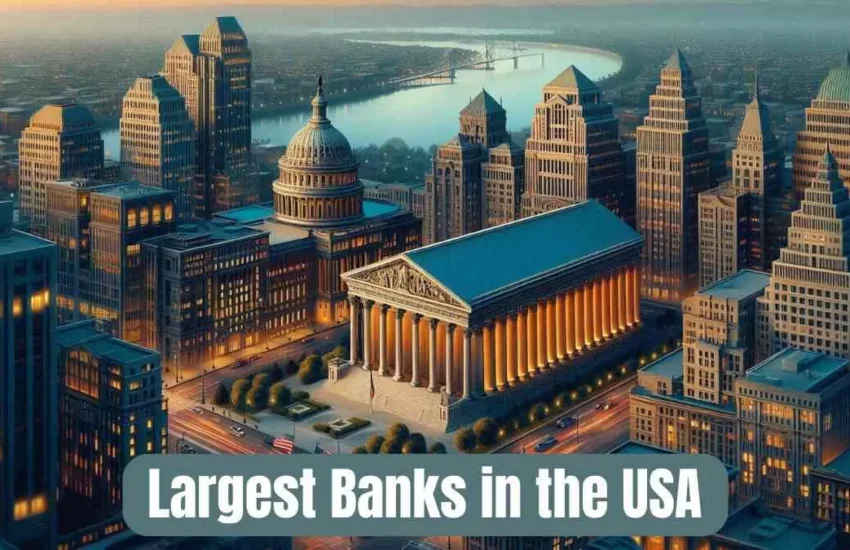The largest banks in the USA are renowned for their broad networks of branches, vast asset holdings, and comprehensive financial services. With institutions that significantly affect both the domestic and international economies, the US banking industry is among the most vibrant and diverse in the world. These massive financial institutions are essential to several industries, such as corporate finance, investment banking, retail banking, and wealth management.
In addition to serving millions of consumers, the largest banks in the USA have a significant impact on financial markets, economic policy, and global projects. The running of the American and worldwide economies depends heavily on these institutions, thus everyone interested in the financial landscape needs to understand the largest banks in the USA.

Top 10 Largest Banks in The USA
1. JPMorgan Chase
- Total assets: US$3.38tn
JPMorgan Chase & Co., with US$3.67 trillion in assets, is the largest bank in North America. Although the current organization was formed in 2000 as a result of the generational merger of JPMorgan and Chase Manhattan Corporation, its origins date back more than 200 years, to 1799. JPMorgan comprises investment banking and asset management, whereas Chase is the company’s consumer banking segment, with around 5,000 branches.
About 290,000 people work for the organization worldwide. In the 20th edition of the Forbes Global 2000 list, which evaluates companies based on revenue, earnings, assets, and market value, JPMorgan rose three spots to take the top spot in 2023. JPMorgan Chase is the biggest financial company in the world and, aside from central banks, arguably the most significant company in terms of the economy, with total assets of around US$3.4 trillion.
2. Bank of America
- Total assets: US$2.4tn
One of the biggest banks in the world and one of the top financial institutions in the US, Bank of America serves a wide spectrum of customers, from small businesses to major corporations, offering both business and personal accounts with a variety of product offerings. It actually has a staggering 56 million customers, including corporations and consumers. With roots extending back 240 years, Bank of America was one of the first financial institutions in the United States.
With US$2.4 trillion in assets under management, the bank is regarded as a major player in the world economy and offers insights into the macroeconomic landscape. Through Merrill (previously Merrill Lynch), Bank of America provides investment and wealth management solutions in addition to its complete range of banking services. With its Preferred Rewards program, Bank of America, a notable name in relationship banking today, provides a number of benefits and incentives to eligible customers.
3. Wells Fargo
- Total assets: US$1.8tn
Wells Fargo, the top bank in the US on the West Coast, is also one of the most accessible banks in the country, with 7,300 locations and 12,000 ATMs around the country, managing assets worth about US$1.8 trillion. The bank, which has its headquarters in San Francisco, has grown its online banking business in recent years in an effort to better serve its clients’ requirements and promote financial success. Since its establishment in 1852, Wells Fargo has developed into a massive US financial institution that currently services one in three US homes and has reached 40 nations and territories.
4. Citibank
- Total assets: US$1.6tn
Citibank, formerly known as City Bank of New York, was established in 1812 and is one of the country’s most prestigious financial organizations. Over the years, it has played a significant role in shaping US financial services, from helping to develop the first ATM to spearheading the current digital transition.
As more fintechs roll out core banking Gen AI solutions to serve financial organizations, CEO Jane Fraser, one of the foremost women in financial services, recently spoke on the significance of adopting and capitalizing on Gen AI in finserv. Citibank is one of the top four US banks with total assets of over $1 trillion, with US$1.6 trillion. In an era of digital transformation, Citibank is a leader in introducing innovative financial innovations.
Read Also: Best Universities For Human Resource Management In Canada
5. U.S. Bank
- Total assets: US$657bn
Through a number of acquisitions, U.S. Bank, which is owned by its Minneapolis-based parent firm U.S. Bancorp, has experienced tremendous development in recent years. The acquisition of MUFG Union Bank’s consumer division by U.S. Bank for US$8 billion in 2021 is one of the most noteworthy mergers in recent memory. This is the bank’s largest M&A transaction since its 2001 merger with Firstar Corp for US$21 billion (~US$35 billion in 2024). Operating over 2,300 offices nationally, U.S. Bank has steadily grown to become the fifth largest bank in the United States, with total assets of US$657 billion as of today.
6. PNC Bank
- Total assets: US$553bn
The most well-known bank in Pennsylvania, PNC, with over 2,600 locations across the country and total assets of US$553 billion. PNC, a division of PNC Financial Services Group, provides financial services through commercial and personal channels, including options for credit cards, savings accounts, house loans, retirement plans, and vehicle loans. PNC, which advocates for “boring banking,” abides by the maxim that the safest financial plan is frequently the best one and frequently provides its clients with financial guidance on its website.
7. Goldman Sachs Bank
- Total assets: US$538bn
Goldman Sachs owns Goldman Sachs Bank, which specializes in investment banking and now has $538 billion in total assets. It is closely associated with Marcus by Goldman Sachs, the financial giant’s online banking division. Presented as a digital challenger bank, Marcus by Goldman Sachs provides retail consumers with no-fee personal loans, online savings accounts, and checking accounts. Since its founding, it has also released a specialized mobile banking app and a consumer credit card in partnership with Apple.
8. Truist
- Total assets: US$535bn
As it happens, Truist, our ninth addition, was the result of yet another merger. Truist was established in 2019 as a result of the merger of BB&T and SunTrust Bank. It now oversees US$535 billion in assets and has 2,000 branches throughout the East and South areas of the US. Under the direction of seasoned financial services executive William “Bill” Rogers, Truist supports in-person banking, making it extensively accessible in physical locations with over 3,000 ATMs in addition to its 2,000 branches.
Read Also: Best Universities For Human Resource Management In Canada
9. Capital One
- Total assets: US$468bn
Established in 1988 by Richard Fairbank and Nigel Morris (now of QED Investors), Capital One is a renowned organization that specializes in credit cards. Since its establishment, Capital One has drawn a contemporary, digitally savvy clientele thanks to its hybrid business model, which primarily focuses on the internet and has a minimal physical presence. In a historic US$35.3 billion deal, the bank recently revealed its intentions to buy Discover Financial. This would be one of the biggest M&A transactions in recent memory and combine the two top credit card firms in America.
10. TD Bank
- Total assets: US$366bn
With US$366 billion in assets, TD Bank, one of the biggest US banks today, is based throughout the East and Northeast Coasts. With 150 years of history, TD Bank is a subsidiary of Toronto-Dominion Bank in Canada. It currently serves 10 million local clients. TD is still dedicated to provide in-person banking services in addition to internet banking and other digital capabilities, and it has over 1,200 offices throughout the East Coast.
Read Also: Top Community Colleges in Canada for International Students
What are the largest banks in the USA by assets?
JPMorgan Chase, Bank of America, Wells Fargo, Citibank, and Goldman Sachs are the five largest banks in the USA in terms of assets. The largest bank in the USA and one of the largest in the world, JPMorgan Chase, tops the list with assets above $3 trillion. A close second with assets above $2.5 trillion is Bank of America. Not to be outdone, Wells Fargo and Citibank have assets of almost $1.7 trillion and $1.6 trillion, respectively. These banks, which provide a broad range of services across several industries, control the financial landscape in the USA.
The largest banks in the USA offer what services?
Both individual and corporate clients can choose from a wide range of financial services provided by the largest banks in the USA. Retail banking services include credit and debit cards, mortgages, and savings and checking accounts. In addition, they offer investment banking services related to capital raising, underwriting, and mergers and acquisitions (M&A).
Another important service is wealth management, which includes asset management and financial advice for high-net-worth clients. In order to assist the operations of both small and large enterprises, these banks also provide corporate banking services such trade financing, cash management, and company loans.
What effect does the largest banks in the USA have on the world economy?
Due to their enormous international operations and financial power, the largest banks in the USA have a substantial impact on the world economy. These banks provide foreign currency services, facilitate cross-border mergers, underwrite international debt and stock issues, and engage in global investment banking.
Through their provision of trade finance and international payment services, they also play a vital role in world trade. Furthermore, these banks have the power to impact global financial markets by their decisions, which can affect anything from commodity pricing to currency exchange rates. These decisions include interest rate policies and investment strategies.

How are the largest banks in the USA able to maintain financial security?
Given their size and power, the largest banks in the USA have financial stability as a top priority. Federal organizations including the Federal Reserve, the Office of the Comptroller of the Currency (OCC), and the Federal Deposit Insurance Corporation (FDIC) have strict regulatory authority over these banks. They must follow tight risk management procedures, keep sufficient capital reserves, and conduct stress tests on a regular basis.
To safeguard the funds and information of their clients, major banks also make significant investments in cybersecurity and fraud prevention. These banks support the general stability of the financial system by upholding regulation and good financial practices.
The largest banks in the USA are currently facing what issues.
The rivalry from fintech startups, technical improvements, and regulatory compliance are some of the problems that the largest banks in the USA must contend with. Because regulatory requirements are always changing, banks must modify their operations to stay compliant, which may be expensive and difficult.
Technological developments like the emergence of digital banking necessitate large investments in cybersecurity and new technology. Fintech businesses are also upping their game against traditional banks by providing cutting-edge financial services and products, frequently at a lower price. The largest banks must be flexible, creative, and forward-thinking in their approach in order to meet these difficulties.
Recommended
- Top 8 Institutions Offering Pharmacology Courses In Australia
- PTE Exam Dates 2024: Full Form, Fees, Dates & Registration
- List of 10 Oldest Universities In The World
- Best Universities For Software Engineering In Canada
How does corporate social responsibility (CSR) affect the largest banks in the USA?
Recognizing their obligation to give back to society beyond their financial operations, the largest banks in the USA are heavily involved in corporate social responsibility (CSR) programs. These banks take part in a range of CSR initiatives, including projects that promote environmental sustainability, educational scholarships, and community development.
JPMorgan Chase, for instance, has made billion-dollar investments in workforce training initiatives, small company development, and affordable housing. Bank of America is renowned for its dedication to ecological sustainability, encompassing the funding of renewable energy initiatives. These programs are an extension of the banks’ efforts to solve larger societal issues and give back to the communities they serve.
SEE ALSO:
Trust you found our article on Top 10 Largest Banks in The USA helpful. Follow our website for more interesting articles.

